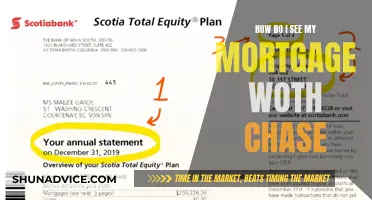
Owner-financed mortgages, also known as seller financing, are an alternative to traditional mortgages where the buyer cannot secure funding through conventional lenders. In this arrangement, the property owner acts as the lender, extending credit to the buyer and eliminating the need for a financial institution. This provides flexibility in the transaction, especially if the parties are already acquainted. The seller-buyer contract can be structured in several ways, including as a second mortgage, a rent-to-own contract, or a wraparound loan, and typically involves a private agreement between both parties. This article will explore the process of selling an owner-financed mortgage, including important considerations and steps to ensure a smooth transaction.
Characteristics and Values of Selling an Owner-Financed Mortgage
| Characteristics | Values |
|---|---|
| Nature of arrangement | The property owner acts as the lender, extending credit to the buyer without involving a traditional mortgage lender. |
| Buyer's profile | Buyers who can't get conventional loans due to credit problems, unconventional income, or lack of assets, short or shaky credit history, or low credit score. |
| Types of contracts | Second mortgage, rent-to-own contract, wraparound loan, land contract, contract for deed, contract of sale, land sale contract, or installment sales contract. |
| Loan terms | Down payment, interest rate, repayment schedule, and default consequences. |
| Security for the loan | A mortgage or trust deed acts as a security instrument, allowing the seller to foreclose if the buyer fails to pay. |
| Sale process | Market analysis, legal documentation, finding a buyer, negotiations and terms finalization, closing process. |
| Buyer evaluation | Credit and payment history, financial situation, and job stability. |
| Costs | Title search, title insurance, homeowners insurance, property taxes, and closing costs. |
| Benefits | Faster closing process, flexibility in terms, no upfront payment of principal, and access to homeownership. |
| Risks | Potential for default, inability to sell or refinance until loan is paid off, and potential for foreclosure. |
What You'll Learn
- Owner-financed property buyers: how to evaluate their credit and payment history
- Owner financing contract types: second mortgage, rent-to-own, wraparound loan
- How to customise financing terms to fit your needs as a seller?
- How to find a buyer for your owner-financed property?
- How to structure a seller-financed deal?

Owner-financed property buyers: how to evaluate their credit and payment history
Owner financing, also known as seller financing, is a type of home loan where the seller provides some or all of the money required for the purchase. This arrangement is particularly useful for buyers who are unable to secure a mortgage through traditional lenders due to a short or shaky credit history or low credit score.
If you are a seller looking to owner-finance, it is important to evaluate the buyer's credit and payment history to ensure they will be able to make the payments and protect yourself from potential defaults. Here are some steps to evaluate the buyer's creditworthiness:
- Obtain a credit report and financial statements: Request a credit report and financial statements from the buyer, including information on their income, expenses, assets, liabilities, and net worth. This will help you understand their financial situation and ability to make payments.
- Review payment history and loan obligations: Analyze the buyer's payment history on existing and past loans, including any pending bankruptcies, civil suits, judgments, tax liens, collection accounts, and records of criminal activity. This will give you an idea of their track record in meeting financial obligations.
- Evaluate income and expenses: Assess the buyer's income sources, such as employment, business, rental, or investment activities. Compare their total income to their total expenses, including housing expenses and other installment payments like credit cards and auto loans. This will help you determine their ability to make regular payments.
- Analyze assets and net worth: Review the buyer's assets, such as stocks, bonds, personal property, businesses, and real estate owned. Calculate their net worth by subtracting their total debt obligations or liabilities from the value of their assets. A higher net worth indicates a stronger financial position.
- Investigate cash flow and debt service coverage: If the property generates income, evaluate whether it can cover its operating expenses and debt service. If there is a negative cash flow, assess the buyer's personal capacity to cover the shortfall by reviewing their financial statements and income sources.
- Conduct a credit check: While owner-financed deals may not have as stringent approval procedures as traditional mortgages, it is still important to run a credit check on the buyer. This will help you identify any red flags or potential credit risks that could impact their ability to repay the loan.
- Work with a real estate attorney: Engage a qualified real estate attorney to represent you during negotiations and review the contract. They can help protect your rights and ensure that all necessary disclosures and documentation are provided by the buyer.
By following these steps, you can make a more informed decision about the buyer's creditworthiness and ability to make payments on an owner-financed property. It is important to carefully weigh the risks and benefits before entering into any owner-financed transaction.
Resetting Your Mortgage: A Guide to Starting Over
You may want to see also

Owner financing contract types: second mortgage, rent-to-own, wraparound loan
Owner financing is an alternative to traditional mortgages where the property owner acts as the lender. This arrangement is also called a second mortgage. In this type of contract, the buyer secures a conventional loan for part of the purchase price, while the seller finances the rest. The seller's loan becomes secondary to the primary mortgage, and they only receive payments after the first mortgage obligations are met. This type of financing is ideal for buyers with credit challenges or unconventional income streams, as it provides a pathway to homeownership that might otherwise be unavailable.
Rent-to-own contracts are another form of owner financing. In this arrangement, the renter has the option to continue renting a property while also having the choice to buy it at a specified time in the future. The buyer is typically allowed 1 to 3 years to pay the agreed amount in full. The seller retains full property rights until the renter fulfils their part of the agreement. The buyer in this scenario remains a tenant until the home's payment is completed, and the seller retains all the rights and responsibilities of homeownership, including repairs.
Wraparound loans are a type of owner-financed mortgage loan. This structure is used when the seller has a remaining balance to pay on the property's first mortgage loan. The buyer signs a promissory note, agreeing to make monthly payments to the seller, who then pays the existing mortgage to their lender. The buyer pays the seller the total purchase price over time, which includes the seller's existing mortgage and an incremental balance. The seller benefits by making a profit, provided the interest rate charged to the buyer is higher than the original mortgage rate.
It is important to note that owner financing deals, especially wraparound loans, can be risky for both buyers and sellers. Buyers may end up paying higher interest rates than with a traditional mortgage, and there is a risk of foreclosure if the original lender does not have a clause in place for an assumable mortgage. Sellers also take on the full default risk on the loan and must ensure their existing mortgage does not include an alienation clause, which could require them to repay the lending institution in full if the collateral is sold.
Protecting Your Documents When Applying for a Mortgage
You may want to see also

How to customise financing terms to fit your needs as a seller
Owner financing, or seller financing, is a type of home loan where the seller provides some or all of the money required for the purchase. The buyer repays that loan to the seller per the terms of the owner financing contract. This arrangement eliminates the need for a financial institution to handle financing agreements and negotiations.
Down Payment
As a seller, you can require a substantial down payment from the buyer. A larger down payment reduces the amount of financing required and provides a greater guarantee that the buyer is committed to the purchase.
Term Length
Owner financing arrangements typically have shorter terms than conventional mortgages, often ranging from five to ten years. As a seller, you can decide on the term length that suits your financial goals and risk tolerance. A shorter term may result in a faster payoff, while a longer term could provide the buyer with more manageable payments.
Interest Rate
You can charge an interest rate on the loan provided to the buyer. The interest rate can be fixed for the duration of the loan or variable, adjusting periodically based on market conditions. Charging an interest rate can increase your income from the loan and compensate for the time value of money.
Repayment Schedule
You can customise the repayment schedule to fit your preferences. You may opt for regular monthly or quarterly payments, or you can structure the payments to align with the buyer's income stream or project milestones. A well-structured repayment schedule ensures timely payments and reduces the risk of default.
Balloon Payment
Some owner financing arrangements include a balloon payment at the end of the term. This involves the buyer making smaller payments throughout the loan term and then paying off the remaining balance in a single large payment, known as a balloon payment. This option may be suitable if the buyer expects to have improved financial capabilities by the end of the term.
When customising financing terms, it is essential to consult with legal and financial professionals to ensure compliance with regulations and to protect your interests as a seller.
Strategies to Remove Private Mortgage Insurance from Your Home Loan
You may want to see also

How to find a buyer for your owner-financed property
If you're looking to sell an owner-financed property, there are a few things to keep in mind to find a suitable buyer. Owner financing, also known as seller financing, is an alternative method where the seller of a property acts as the lender for the buyer. This is often an attractive option for buyers who may not qualify for traditional loans or those who prefer a more flexible financing arrangement. Here are some steps and tips to help you find a buyer:
- Understand the Market: Owner-financed properties can be more appealing in a slow market or if the property is unique and may not appeal to conventional buyers. By understanding the market conditions, you can time your sale to increase its attractiveness.
- Prepare the Property: Before listing the property, ensure it is in good condition and make any necessary repairs or improvements. A well-maintained property will likely attract more buyers.
- Determine the Terms: Clearly define the terms of the owner financing, including the down payment, interest rate, loan term, and payment schedule. Be prepared to negotiate these terms with potential buyers to reach a mutually beneficial agreement.
- Advertise the Owner Financing: When listing the property, explicitly mention that you're offering owner financing. This can be done through various online platforms, local newspapers, or by working with a real estate agent familiar with owner-financed transactions.
- Screen Potential Buyers: Conduct a thorough evaluation of potential buyers' credit and payment history. Assess their financial situation, including job stability and income, to gauge their ability to make regular payments.
- Work with a Real Estate Attorney: It is essential to have a real estate attorney involved in the process. They can help draft the necessary legal documents, such as a promissory note, land contract, or mortgage, and ensure that the transaction complies with all legal requirements.
- Finalize the Sale: Once you've found a suitable buyer and agreed on the terms, finalize the sale by signing the necessary documents and transferring the title to the buyer. Make sure a real estate attorney or title company handles the closing process correctly.
Remember, owner financing may not be suitable for every buyer or property. Be diligent in your search for a buyer, and don't hesitate to negotiate and customize the financing terms to fit your needs and goals.
Minimizing Mortgage Principal: Strategies to Reduce Your Debt
You may want to see also

How to structure a seller-financed deal
Owner financing, also known as seller financing or creative financing, is a type of real estate agreement where the seller provides some or all of the financing directly to the buyer. This arrangement can be beneficial for buyers who don't qualify for traditional mortgages due to poor credit history or unconventional income. It can also offer faster closing processes and more flexible terms.
Consult Professionals:
Engage qualified professionals, such as attorneys or real estate agents, to guide you through the process and ensure your interests are protected. These professionals can assist in drafting the necessary documentation, including promissory notes, contracts, and other legal paperwork.
Due Diligence:
As a seller, mitigate the risk of buyer default by requiring a detailed loan application form and thoroughly vetting the buyer's financial situation. This includes running a credit check, verifying employment, and assessing assets, financial claims, and references.
Negotiate and Agree on Terms:
Both parties should negotiate and agree on all aspects of the financing arrangement, including the purchase price, down payment amount, interest rate, repayment schedule, and term length. The written sales contract should specify these terms along with the loan amount and interest rate, and it should be contingent upon the seller's approval of the buyer's finances.
Structure of Payments:
Owner financing agreements can be structured in several ways, including as a second mortgage, a rent-to-own contract, or a wraparound loan. The buyer makes instalment payments directly to the seller, and the seller typically retains the deed to the property until the buyer pays in full. The agreement should also specify who is responsible for taxes and insurance payments, which are typically paid directly to the relevant agencies in owner financing deals.
Balloon Payments:
Many seller financing arrangements run for shorter periods, often five to ten years, and conclude with a balloon payment. This is a lump sum paid at the end of the repayment period, after which the buyer may need to refinance with a conventional lender to pay off the seller.
Land Contracts:
In a land contract, the seller maintains legal title to the property until the buyer completes all payments. The buyer receives equitable title, which gives them possession of the property during the repayment period but doesn't confer official ownership until the contract terms are fulfilled.
Remember, each real estate deal is unique, so ensure your owner financing agreement is tailored to your specific circumstances and includes any relevant details or requirements. Consult with professionals and do your research to understand the risks and benefits of this non-traditional mortgage option fully.
Removing Yourself from a Mortgage: The Complete Guide
You may want to see also
Frequently asked questions
Owner financing is an arrangement in which a homeowner or seller, rather than a bank or mortgage lender, extends credit to a buyer, making a purchase possible. The buyer repays that loan to the seller per the terms of the owner financing contract.
To sell an owner-financed mortgage, you need to perform a market analysis to evaluate the property's fair market value. Then, draft all legal documents, including the financing agreement, depending on the terms of the transaction. After that, find a buyer and negotiate the terms of the sale, including the sale price, interest rate, and payment schedule. Finally, ensure that a real estate attorney or Title Company handles the closing process correctly and complies with all relevant laws.
Owner financing can provide flexibility that traditional mortgages often lack, potentially simplifying what can otherwise be a complex transaction. It can also be a pathway to homeownership for those who don't meet conventional mortgage requirements and can result in a faster closing process by avoiding the lengthy mortgage approval process.







